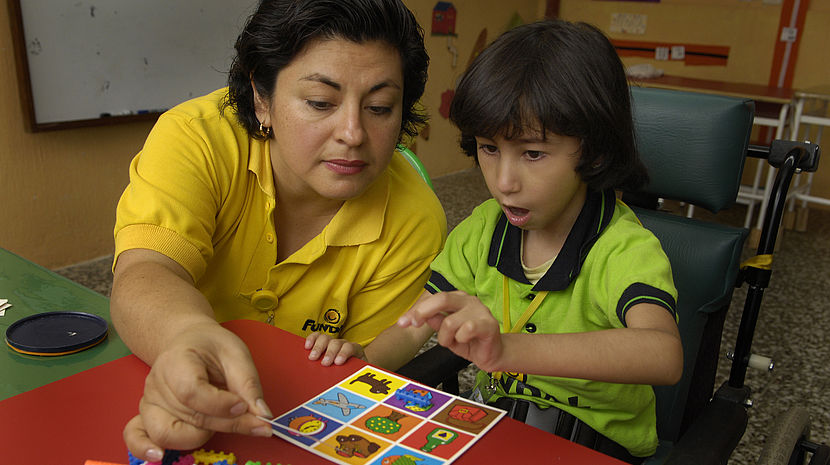Guatemala National Disability Survey (ENDIS)

Renata, a young girl with cerebral palsy and hearing problems, learns sign language with her teacher at Fundal School in Guatemala City.
CBM/Grossmann
CBM together with the CONADI (National Disability Council of Guatemala), UNICEF and the International Centre for Evidence in Disability conducted a national disability survey in Guatemala. The survey was the most comprehensive of its kind ever undertaken in Latin America.
The Guatemala National Disability Survey (ENDIS) was undertaken to gain disability disaggregated population data and understanding of the lived situation for people with disabilities in order to inform and motivate evidence-based advocacy, policy and service planning.
The study had three components:
- A population based survey to estimate the prevalence of disabilities.
- A case-control study to compare people with and without disabilities in terms of their socio-economic situation and their use of education, health, water and sanitation, and employment services.
- A qualitative component to explore the conceptual, cultural and social interpretation and responses to disability.
Key findings
1. Prevalence of disability
- The overall prevalence of disability was 10.2 %.
- Overall, 31% of the households included in the survey included at least one household member with a disability.
- Prevalence increased with age (children (<18 years): 5.3%, adults 18-49 years: 9.9% and adults 50+ years 24.1%).
- Among adults the prevalence of disability was higher for women compared to men.
- By functional domain, the prevalence of significant limitations among adults was highest in the domains of anxiety/depression (9.3%) mobility (8.0%), seeing (4.2%) and hearing (4.0%). Amongst children the domains with highest reported significant limitations were anxiety (1.9%), mobility (1.0%), and maintaining relationships (1.0%).
- Comparing people with and without disabilities, people with disabilities were more likely to be in the poorest socio-economic group, had lower access to education and were less likely to have ever married or lived with a partner.
2. Welfare of people with disabilities compared to people without disabilities
- In rural areas children with disabilities (61%) were less likely to be attending school compared to children without disabilities (82%). In urban areas school attendance was over 80% for both children with and without disabilities. Girls with disabilities were significantly less likely to be attending school than girls without disabilities.
- Adults with disabilities were significantly less likely to have worked in the previous week compared to adults without disabilities and had less stable livelihoods (i.e. more likely to work only once in a while compared to throughout the year).
- People with disabilities had higher reported participation restrictions, experienced greater environmental barriers, and had poorer self-rated quality of life compared to people without disabilities.
- People with disabilities were more likely to have reported a serious health problem in the past 12 months and were more likely to have been diagnosed with high blood pressure.
- Women of reproductive age (15-49 years) with disabilities were less likely to have sought antenatal care in their last pregnancy (within the past 5 years), but were more likely to have delivered their baby in a health centre or hospital (rather than at home) and have the birth assisted by a doctor.
- Reported vaccination coverage was high for both children with and without disabilities.
3. Welfare among people with disabilities
- Child school attendance was lowest in rural areas and among girls.
- Poorer quality of life was associated with lower socio-economic status and living in a rural area.
- Adults with no formal education were less likely to work.
- Children with physical or cognitive limitations had the lowest access to school and adults with physical or cognitive limitations were the least likely to work, and reported the lowest participation and quality of life scores.
4. Qualitative study
- Findings highlight a scenario of deep conceptual complexity, marking out disability as a notion and experience that is fluid, heterogeneous and dynamic.
- In the absence of safety nets and assets, families and poor communities, for better or for worse, are the only source of survival for disabled people.
- Whole families are cast into the most extreme and chronic poverty positioning these as the poorest of the poor- ‘disabled families’. This situation is created and perpetuated by deep structural inequalities and a policy and service landscape marked by disinterest in the plight of the poor, profound gaps and barriers.
Guatemala National Disability Study
Disability and Poverty in Rural Guatemala. Qualitative report
Please contact us for the accessible versions of the survey at contact(at)cbm(dot)org.